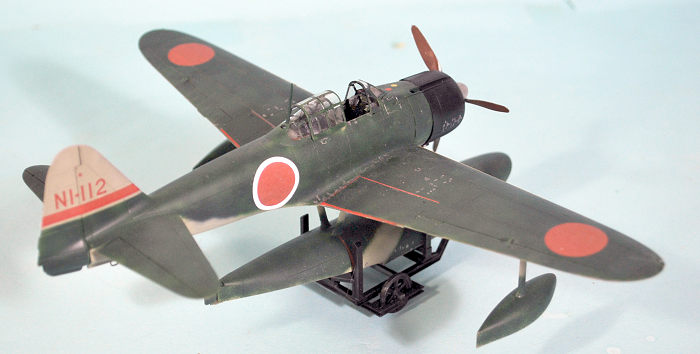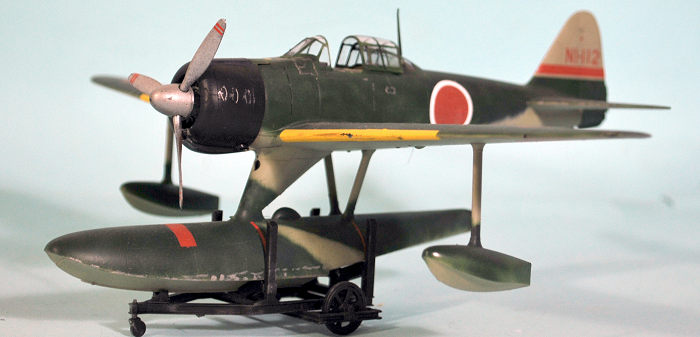
Eduard 1/48 A6M2-N Rufe
| KIT #: | 11171 |
| PRICE: | $97.99 |
| DECALS: | Eight options |
| REVIEWER: | Tom Cleaver |
| NOTES: | Dual ComboI |

| HISTORY |
 Following delays in the design and development of the Kawanishi N1K1
floatplane fighter, Nakajima designed the A6M2-N (Navy Type 2
Interceptor/Fighter-Bomber) as a single-seat floatplane based on the
Mitsubishi A6M Zero Model 11. The Allied reporting name for the aircraft was
“Rufe.”
Following delays in the design and development of the Kawanishi N1K1
floatplane fighter, Nakajima designed the A6M2-N (Navy Type 2
Interceptor/Fighter-Bomber) as a single-seat floatplane based on the
Mitsubishi A6M Zero Model 11. The Allied reporting name for the aircraft was
“Rufe.”
The A6M2-N was based on the A6M-2 Model 11 fuselage, with a modified tail and added floats. It’s main purpose was to support amphibious operations before a land base could be established, and defend remote bases. A total of 327 were built, including the original prototype.
The prototype flew on December 7, 1941. No problems were encountered and it immediately entered production, with the first examples being allocated to combat units in early May 1942. The A6M2-N was pressed immediately into the Solomons and Aleutian campaigns. In the Solomons, the airplane proved to be far more of a problem for Allied fighter pilots than its somewhat-ungainly appearance suggested, since it was only slightly less maneuverable than the land-based Zero; its primary difficulty was its relatively low top speed of around 270mph and lower climb rate compared with the land-based Zero.
 The first A6M2-Ns were assigned to the Yokohama Kokutai at Rabaul,
arriving in early June 1942. This small detachment was further dispersed to
Tulagi where they were to provide cover for construction of an airfield on
neighboring Guadalcanal. Several were destroyed on the water during the
American landings in August. Later, a detachment operated from nearby Rekata
Bay and the A6M2-Ns often tangled with Wildcats over Henderson Field.
The first A6M2-Ns were assigned to the Yokohama Kokutai at Rabaul,
arriving in early June 1942. This small detachment was further dispersed to
Tulagi where they were to provide cover for construction of an airfield on
neighboring Guadalcanal. Several were destroyed on the water during the
American landings in August. Later, a detachment operated from nearby Rekata
Bay and the A6M2-Ns often tangled with Wildcats over Henderson Field.
A second unit was assigned to the Toko Kokutai, operating in the Aleutian Islands. This detachment was deployed to Kiska island. During the “Kiska Blitz” they opposed bombing raids on every day that the weather allowed. The unit first engaged in combat on August 4, 1942, intercepting B-24s over Kiska. They had occasional success against American fighters. Following the recapture of Attu and Kiska, the 452 Kokutai also operated A6M2-Ns from Paramushiro in the Kurile Islands, attempting defend these remote northern islands from American attacks. The A6M2-N also saw service aboard he Japanese raiders Hokoku Maru and Aikoku Maru in Indian Ocean raids.
Rufes shot down B-17s and B-24s in both the Solomons and Aleutians, and were successful against the F4F-4 Wildcat, P-39 Airacobra, P-40 Warhawk and P-38 Lightning if these fighters attempted to engage the Rufe at speeds under 250mph, as was the case with the land-based Zero. In 1944, the Otsu Air Group flew the A6M2-N as an interceptor alongside the Kawanishi N1K1 Kyofu, based on Lake Biwa on Honshu.
| THE KIT |
 The first A6M-2N kit was produced by Tamiya and appeared in 1973;
that kit is still available today and makes up into an acceptable model.
This was followed in the 1990s by Hasegawa, with a better, more accurately
detailed kit.
The first A6M-2N kit was produced by Tamiya and appeared in 1973;
that kit is still available today and makes up into an acceptable model.
This was followed in the 1990s by Hasegawa, with a better, more accurately
detailed kit.
Eduard’s Rufe is part of their Zero collection, and is as highly detailed as the A6M2 and A6M3 kits released so far, making it the best kit of the A6M2-N if accuracy and solid detail are the criterion.
This first release of a double kit includes decals for no less than eight different airplanes. The Profipack single kit release came out in August 2023, a month after the release of the Double Kit.
| CONSTRUCTION |
Outside of the floats instead of landing gear, this kit makes up similarly to the other Eduard Zeros. If a modeler takes care in cleaning up all mating surfaces and takes their time with assembly, no filler will be necessary.
The central pontoon has the foward lower section separate, which allows a modeler to attach sufficient weight in the front end of the pontoon to allow the model to sit right in its cradle without tipping back on its tail.
| COLORS & MARKINGS |
 I used Gunze-Sangyo Nakajima Cockpit Green for the cockpit, and Tamiya
XF-76 “IJN gray-green,” which is actually the Nakajima version of this color. I
used Mr. Color C-15 “Nakajima Dark Green” for the upper color, which was applied
in the field over the gray-green; I made sure that this application allowed
“holes” for the lower color to show through.
I used Gunze-Sangyo Nakajima Cockpit Green for the cockpit, and Tamiya
XF-76 “IJN gray-green,” which is actually the Nakajima version of this color. I
used Mr. Color C-15 “Nakajima Dark Green” for the upper color, which was applied
in the field over the gray-green; I made sure that this application allowed
“holes” for the lower color to show through.
Kit decals were used. I do not involve myself with trying to lift off the decal film on Eduard decals; I just use them in the traditional method since I am not interested in harming the decals in the last stage of the project.
I applied light weathering to the model. The history on this airplane is that it didn’t last that long after it received the field-applied camouflage.
| CONCLUSIONS |
The Eduard Rufe is up to the quality level of their other Zero kits, making this the best kit available of the A6M2-N. Recommended for all fans of Japanese naval aviation.
31 August 2023
Back to the Previews Index Page
Back to the Previews Index Page